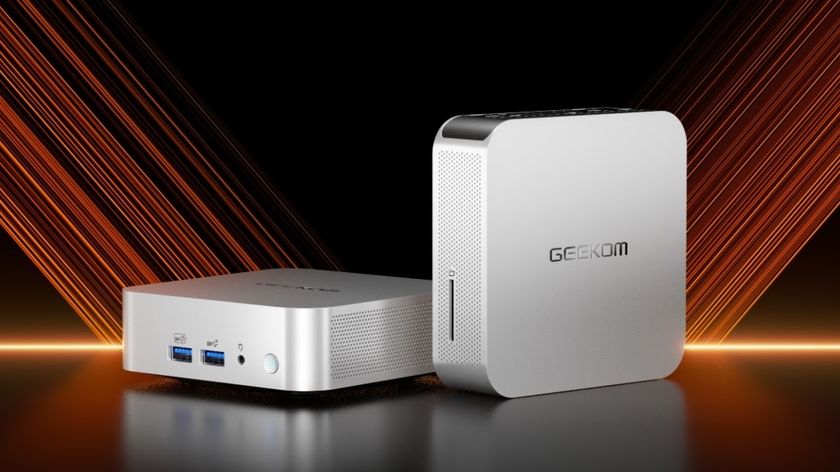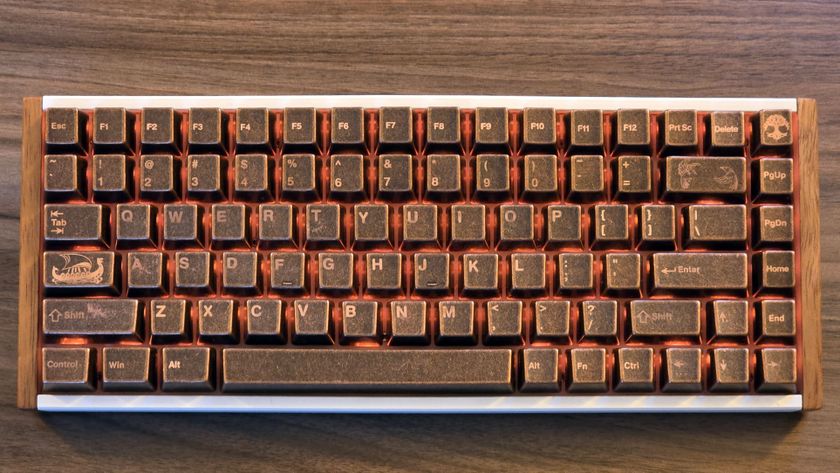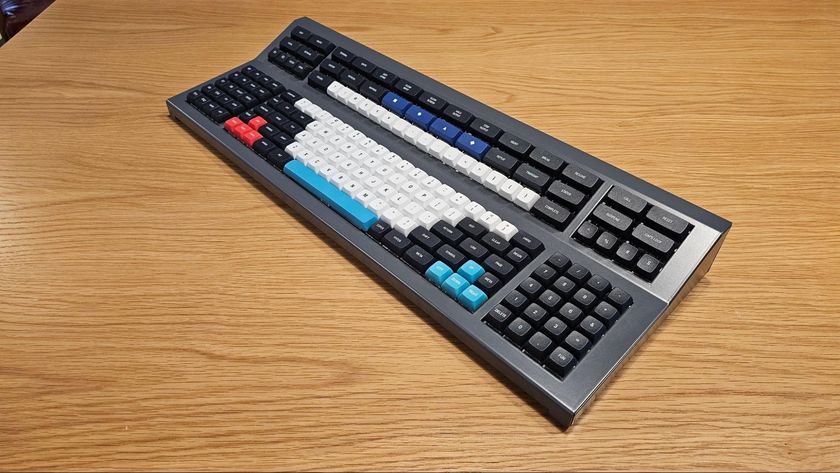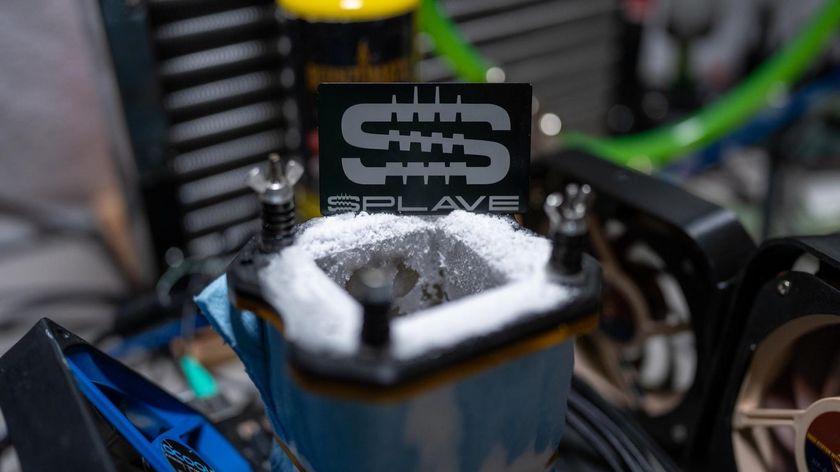Does Size Matter? Four Very Small Nettops Get Reviewed
We're comparing four diminutive PCs: ASRock’s Vision HT, Jetway’s Mini-Top JBC700, Lenovo’s Q180, and Zotac’s Zbox Nano XS AD11 Plus. Despite their similar sizes, each tiny computer offers a unique feature set. Are any of them right for you?
Zotac Zbox Nano XS AD11 Plus
Zotac's Zbox Nanos stand out for their extremely small size and surprising potency. The AD11 includes AMD’s 1.65 GHz E-450 APU with Radeon HD 6320 graphics able to run as fast as 600 MHz. Selling for $380 on Newegg, this is the least-expensive system in our story with a processor, hard drive, and memory.

Measuring 4.25” x 4.25” x 1.5”, the tiny Zbox's largest dimension is even smaller than the length of my hand. Like other Zboxes, when the AD11 is powered on, a ring-shaped light inside the top cover comes on. Because this is an AMD-based configuration, that light is green.
Together with the black top/bottom and brushed metal sides, this Zbox nano XS AD11 looks sharp.

Room for I/O is limited, so Zotac choose HDMI as the only display output option around back. Additionally, you get two USB 3.0 ports, two USB 2.0 ports, gigabit Ethernet, and a power supply interface. Considering the Nano AD11's size, we weren't expecting much more. It's really just nice to get four total USB ports.

The front panel hosts a combo eSATA/USB port (the sticker under it is removable), an infrared sensor for the included MCE remote, a power button, a card reader, and a couple of 1/8" audio jacks. Again, given this product's size, that's plenty of I/O. Though, if we wanted to nitpick, more front-accessible USB would be nice.
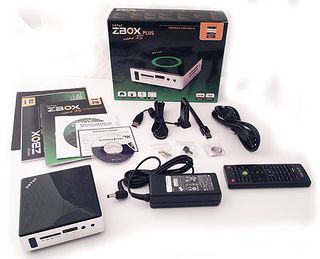
Zotac’s Zbox nano XS AD11 includes an external power supply, software CDs, a manual, a quick-start guide, a VESA bracket for attaching the system to the back of a monitor, a secondary IR sensor on a long cable (which is extremely useful if the system is, in fact, mounted behind a monitor), a wireless dongle, and a Windows Media Center Edition remote with two batteries. We’ve complained about other Zboxes that don’t come with a remote, so we’re happy to see Zotac take this into consideration with its AD11. No operating system is included.
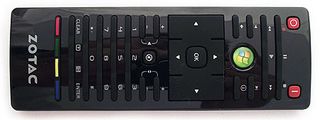
Zotac’s MCE remote is the same model we’ve seen bundled with ASRock's machines. It’s a functional piece of hardware that gets its job done, despite buttons that are smaller than we'd like. This one is painted black and has the company’s logo at the bottom. We observed about 180 degrees of usable area, and the remote worked at the farthest point in our room, about 15 feet from the AD11. Of course, you could also set up the secondary, wired sensor for even more flexibility with reception.
Stay On the Cutting Edge: Get the Tom's Hardware Newsletter
Get Tom's Hardware's best news and in-depth reviews, straight to your inbox.

Getting to the AD11's hard disk and memory is easy. The rubber feet on the bottom of the unit are actually screws, and you don't need any tools to remove them. Inside, we see Kingston's mS100 64 GB SSD and a 2 GB memory module running at 670 MHz. The RAM can be upgraded to 4 GB, and the SSD does wonders for this tiny PC's responsiveness, despite otherwise-modest system specifications.

Zotac's Zbox nano XS AD11 BIOS is about what you’d expect from a configuration based on a platform designed for mobile applications. It includes a number of feature settings, but nothing to alter performance. You can tweak the memory voltage, though.
Current page: Zotac Zbox Nano XS AD11 Plus
Prev Page Lenovo Q180 31102BU Next Page Test Systems And Benchmarks-
Nintendo Maniac 64 So I'm guessing there aren't any nettops yet that use the low-voltage Trinity APUs? (17w A6-4455M and 25w A10-4655M)Reply -
daglesj Beware with the Lenovo Q180 if you buy the barebones DOS version to install Windows 7 64bit on it.Reply
The Audio doesn't work. The drivers Lenovo have up on the site are incorrect for 64bit. So far they haven't got round to changing it after 6 months.
If you buy the version with Windows 64bit installed it works. But they just wont release the right driver. -
The big problem with net tops is longevity and lack of upgrade abilities. If all you plan to do with them is surf the web,send email, chat and watch 2D video. You most likely won't care what hardware is in them. But that's not the negative about these small form factors. Its heat, and a question of how that heat will affect the hardware in such a small form? Not to mention the small PSU's and the question of why would you buy one of these over a decent well designed notebook? Even if you like the form factor and want to run Linux on one of these. Chances are Linux will challenge you on some problem with the hardware.Reply
-
daglesj For day to day office work they do the job perfectly. I know quite a few businesses that are keen to drop their old 130W desktop boxes for something easier on the power bill. I rolled out a load of Atom ION boxes about 3 years ago and all of them are still going strong in some quite challenging environments. A few of them were even overclocked to give a little extra pep and no problems yet.Reply
The main thing that holds these boxes back are the HDDs. They still keep slipping 5400rpm drives in them. You put a 120GB SSD in there and you have a near perfect general office PC. -
silverblue Looking at the D2700 vs. the 450 reminds me of days gone by with the P4D and the Athlon 64 X2. The higher clock speed plus HT of the Atom helps a lot with encoding but despite its clock speed disadvantage, the 450 easily holds its own.Reply
The next generation of both these CPU families would be worth watching out for. -
jaquith I've been debating about purchasing a MINI PC vs Building, sadly one of my HTPC's just recently took a swan dive. So do I purchase something like the ASRock Vision HT for ~$700+ ($800), Build or Repair?!Reply
The only potential drawback to these MINI PC's as an HTPC is lacking of an internal 'TV Tuner' option. However, since Cable DVR's are very common place now the 'TV Tuner' need is getting smaller every day. I have Verizon FiOS and the newer black DVR's and a HTPC to record requires a CableCARD and PCIe CableCARD e.g. Ceton InfiniTV 4 but then you run into oddball things like "Copy Once."
The Pro's & Con's are all from their size, but ~$700+ is a huge price and IMO reduces the demand. The only complete system in this article is the Lenovo Q180, the ASRock Vision HT 821B requires some form of OS and sure there's 'free' OSes but Windows 7 Home Premium OEM 64-bit will add an additional $100.
Any of these listed can be used as a simple Desktop replacement. The workaround for storage is to either purchase a large capacity 'drive' (SSD or HDD) that can 'fit' or some form of external storage including an external drive (USB or eSATA if applicable) or Windows Home Server or similar network storage device. -
chewy1963 silverblueLooking at the D2700 vs. the 450 reminds me of days gone by with the P4D and the Athlon 64 X2. The higher clock speed plus HT of the Atom helps a lot with encoding but despite its clock speed disadvantage, the 450 easily holds its own.The next generation of both these CPU families would be worth watching out for.Reply
Just about the same performance between them back in the day. Of course it's different OS's and software, but, that was from the good ole days when Athlon 64 x2 ruled the x86 performance race. -
stevelord I bought an Asus nettop last year from Walmart. And despite putting a SSD in it + 4GB of memory, it crawled at even loading web pages...especially forums. Wife noticed the speed difference and after lots of complaining sent me back to return it.Reply
-
cleeve Nintendo Maniac 64So I'm guessing there aren't any nettops yet that use the low-voltage Trinity APUs? (17w A6-4455M and 25w A10-4655M)Reply
I couldn't find any, but this article has been in the works for a while so some might have cropped up. -
cleeve jaquithThe only potential drawback to these MINI PC's as an HTPC is lacking of an internal 'TV Tuner' option.Reply
The Jetway Mini-Top in this article *does* have an internal TV tuner option. :)
